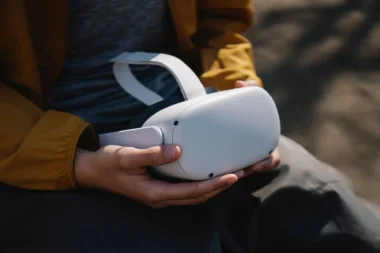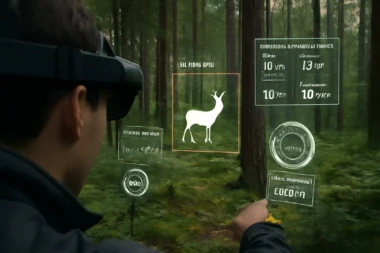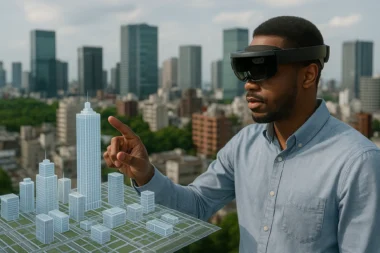Introduction:
Virtual reality (VR) has evolved to provide immersive and interactive experiences, and one significant advancement in this field is touchless interaction through hand-tracking technology. This technology enables users to navigate and interact with virtual environments without needing handheld controllers or physical touch.
The Rise of Hand Tracking Technology
Hand-tracking technology has gained momentum in recent years thanks to computer vision, machine learning, and sensor technology advancements. It uses cameras or other depth-sensing devices to capture and interpret the movements and positions of the user’s hands in real time. This allows for precise tracking of hand gestures and finger movements, mimicking natural interactions and providing a more intuitive way to interact with virtual objects and environments.
How Hand Tracking Works:
1. Sensor Acquisition: Hand-tracking technology typically employs depth-sensing cameras or sensors to capture the position and movement of the user’s hands. These sensors measure the depth information of the hands and track their motion in three-dimensional space.
2. Data Processing: The captured sensor data is processed using complex algorithms and machine learning techniques. These algorithms analyze and interpret the depth information, extracting relevant features and identifying hand gestures and finger movements.
3. Hand Pose Estimation: Hand tracking algorithms estimate the pose and position of the user’s hands based on the processed data. This involves determining the fingers’ and hand’s real-time status, orientation, and joint angles. Sophisticated machine learning models, such as convolutional neural networks (CNNs) or recurrent neural networks (RNNs), are often employed to achieve accurate and robust hand pose estimation.
4. Gesture Recognition: Hand-tracking technology can recognize and interpret hand gestures, including grabbing, pointing, swiping, and more. Gesture recognition algorithms analyze the hand pose data to identify specific gestures and map them to predefined actions or interactions within the virtual environment.
Algorithm used
The specific algorithms used in hand-tracking technology can vary depending on the implementation and the underlying hardware and software. However, here is an overview of the general algorithmic process involved in hand tracking:
1. Hand Detection: The algorithm begins by identifying and detecting the presence of hands within the captured sensor data, typically using computer vision techniques. This may involve analyzing depth maps, RGB images, or both to locate regions of interest that potentially contain hands.
2. Hand Segmentation: Once hands are detected, the algorithm performs hand segmentation to separate the hands from the background or other objects in the scene. This process involves distinguishing the pixels or points belonging to the hand from the rest of the image using methods like color-based segmentation, background subtraction, or deep learning-based techniques.
3. Hand Tracking Initialization: The algorithm initializes the tracking process by estimating the initial pose or position of the hands. Utilizing prior knowledge of hand shape and structure or methods like template matching or model fitting can help achieve this.
4. Hand Pose Estimation: The algorithm then tracks the movement and changes in hand pose over time. It estimates the positions, orientations, and joint angles of the fingers and hand using various mathematical and machine-learning approaches. This can involve using statistical models, such as articulated hand models or kinematic chains, and optimization techniques to refine the pose estimation.
5. Gesture Recognition: Hand tracking algorithms often include gesture recognition capabilities to interpret hand movements and identify specific gestures or interactions. Machine learning techniques, such as neural networks or decision trees, can classify and recognize gestures based on the tracked hand pose data.
6. Real-Time Tracking and Updates: The hand tracking algorithm continuously updates the hand pose estimation in real-time as new sensor data becomes available. This allows for smooth and responsive tracking, ensuring the virtual environment accurately reflects the user’s hand movements and gestures.
7. Noise Reduction and Filtering: To enhance the accuracy and stability of hand tracking, noise reduction and filtering techniques may be applied. These techniques can include smoothing filters, outlier rejection methods, or temporal filtering to reduce noise and jitter in the tracked hand pose.
Technology used
In virtual reality, hand-tracking technology for touchless interaction typically utilizes hardware and software technologies. Here are some of the critical technologies commonly used:
1. Depth-Sensing Cameras: Depth-sensing cameras are crucial in capturing the hand movements and depth information required for hand tracking. These cameras, such as structured light or time-of-flight cameras, measure the distance between the camera and objects in the scene, allowing for accurate depth perception.
2. Infrared Sensors: Infrared (IR) sensors, often integrated into depth-sensing cameras, emit and capture infrared light to measure depth information. These sensors help detect and track hand movements by capturing the reflections of infrared light from the user’s hands.
3. Computer vision: To process the visual data that depth-sensing cameras have captured. This includes image processing, feature extraction, and pattern recognition algorithms to identify and track the hands within the captured frames. These algorithms help in hand detection, segmentation, and pose estimation.
4. Machine Learning and Neural Networks: Machine learning algorithms, including deep learning techniques such as convolutional neural networks (CNNs) or recurrent neural networks (RNNs), are often used to enhance the accuracy and robustness of hand tracking. These algorithms learn to recognize hand poses, gestures, and movements from labeled training data, enabling more precise monitoring and gesture recognition.
5. Sensor Fusion: Hand tracking systems may employ sensor fusion techniques to combine data from multiple sensors, such as depth cameras, gyroscopes, and accelerometers. This fusion of sensor data helps improve the accuracy and reliability of hand tracking by compensating for the limitations of individual sensors.
6. Real-Time Processing: Hand-tracking systems require potent processors and algorithms capable of real-time data processing. The processing unit, often integrated into the VR headset or a dedicated processing unit, performs complex calculations and algorithms to estimate hand poses and track movements with minimal latency.
7. Software Development Kits (SDKs): Companies developing hand-tracking technology often provide developers with software development kits (SDKs). These SDKs include libraries, APIs, and tools that facilitate the integration of hand-tracking capabilities into virtual reality applications and experiences.
8. Firmware and System Integration: Hand-tracking technology may involve firmware updates and system-level integration with the VR headset or platform to ensure seamless operation and compatibility. This integration consists of synchronizing the hand-tracking data with the virtual environment, rendering, and interaction systems.
Benefits of Touchless Interaction:
1. Intuitive and Natural Interactions: Hand-tracking technology allows users to interact with virtual objects using their own hands, creating a more intuitive and natural interaction paradigm. Users can grab, manipulate, and interact with virtual objects as if they were physically present.
2. Enhanced Immersion: Touchless interaction eliminates the need for handheld controllers, enabling a more seamless and immersive experience. Users can directly engage with the virtual environment, enhancing their sense of presence and immersion in the virtual world.
3. Accessibility and Ease of Use: Hand-tracking technology simplifies the VR experience by eliminating the need for additional hardware or complex button configurations. This accessibility makes VR more user-friendly and expands its reach to a broader audience.
4. Realistic Social Interactions: Touchless interaction enables users to communicate and interact with virtual characters or other users more naturally and realistically. Gestures and hand movements can be used for non-verbal communication, fostering more engaging social interactions within VR environments.
Applications and Future Potential:
Touchless interaction through hand-tracking technology has vast implications across various industries and applications.
1. Gaming and Entertainment: Touchless interaction brings new possibilities for immersive gaming experiences, enabling users to interact with virtual objects and environments using hand gestures directly.
2. Training and Simulation: Hand-tracking technology finds applications in training and simulation scenarios such as medical training, virtual assembly simulations, or architectural walkthroughs. Users can perform complex tasks and interact with virtual environments without physical constraints.
3. Design and Creativity: Artists and designers can utilize touchless interaction to sculpt virtual objects, paint in 3D space, or manipulate virtual tools with their hands, fostering creativity and exploration.
4. Rehabilitation and Therapy: Hand-tracking technology can be utilized in rehabilitative and therapeutic applications, aiding in motor skills training, hand-eye coordination exercises, or virtual rehabilitation scenarios.
As hand-tracking technology advances, we can expect even more sophisticated and accurate systems, enabling finer details in finger tracking and expanding the range of gestures and interactions available within virtual reality.
Conclusion:
Touchless interaction through hand-tracking technology reshapes how we interact with virtual reality environments. By eliminating the need for handheld controllers and physical touch, this technology offers a more intuitive and immersive experience, unlocking new gaming, training, creativity, and more possibilities. As hand-tracking algorithms and sensor technology evolve, we can anticipate even greater precision and realism in touchless interaction, further blurring the lines between the physical and virtual worlds.



